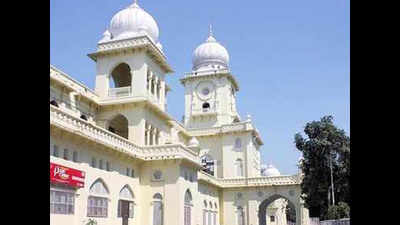- News
- City News
- lucknow News
- A raja’s idea to bridge religious gap shaped Lucknow University
Trending
This story is from November 13, 2019
A raja’s idea to bridge religious gap shaped Lucknow University
Among the many inspirations behind setting up of LU was one more beautiful than the others.

Lucknow University
LUCKNOW: Among the many inspirations behind setting up of LU was one more beautiful than the others.
At a time when divisions based on religion were creeping into Indian society, the idea of Lucknow University was thought of to promote communal amity. This led to the Ganga-Jamuni tehzeeb of Lucknow later playing a significant role in Hindu-Muslim unity during the freedom struggle.
It was in 1920 that then Raja of Mahmudabad thought of establishing a university free of communal affiliations.By that time, the Muhammadan Anglo-Oriental College in Aligarh had been transformed into Aligarh Muslim University (AMU) for imparting education to Muslims youth while before that, in 1916, the Banaras Hindu University (BHU) had been established in Varanasi.
“My grandfather Raja Sir Mohammad Ali Mohammad Khan (Khan Bahadur, KCIE) of Mahmudabad was the founding vice-chancellor of AMU. However, after serving for some time, he became disillusioned with the concept of having educational institutions on communal names and affiliations. A Muslim university was being run by one system, while a Hindu university had its own set-up. This division, he felt, would later reflect in Indian society. He realised that the university should be a place of equality in opportunities. It gave rise to a desire for an institution free from cultural or religious influences,” said 75-year-old Raja Amir Mohammad Amir Khan, a descendant of Raja of Mahmudabad, narrating how LU was born.
With this thought, the Raja contributed an article to a prominent daily newspaper, urging the foundation of a university at Lucknow. The request by him also finds a mention in the first journal of Lucknow University published in 1922. Khan then approached his friend Sir Spencer Harcourt Butler, the first governor of United Provinces of Agra and Oudh, to establish a university in Lucknow, the de facto capital of the United Provinces. The idea simultaneously also got support from other taluqdars of the region and together, they all laid the foundation of LU.
“The idea of promoting Muslim and Hindu cultures together also found reflection in the efforts of Raja Saheb and Taluqdar friends in courses at LU. They ensured Persian, Arabic and Sanskrit courses under one roof at LU. This allowed students from humble backgrounds or those not from an English-speaking school to get an opportunity to attain higher education in their own language,” he said.
At a time when divisions based on religion were creeping into Indian society, the idea of Lucknow University was thought of to promote communal amity. This led to the Ganga-Jamuni tehzeeb of Lucknow later playing a significant role in Hindu-Muslim unity during the freedom struggle.
It was in 1920 that then Raja of Mahmudabad thought of establishing a university free of communal affiliations.By that time, the Muhammadan Anglo-Oriental College in Aligarh had been transformed into Aligarh Muslim University (AMU) for imparting education to Muslims youth while before that, in 1916, the Banaras Hindu University (BHU) had been established in Varanasi.
“My grandfather Raja Sir Mohammad Ali Mohammad Khan (Khan Bahadur, KCIE) of Mahmudabad was the founding vice-chancellor of AMU. However, after serving for some time, he became disillusioned with the concept of having educational institutions on communal names and affiliations. A Muslim university was being run by one system, while a Hindu university had its own set-up. This division, he felt, would later reflect in Indian society. He realised that the university should be a place of equality in opportunities. It gave rise to a desire for an institution free from cultural or religious influences,” said 75-year-old Raja Amir Mohammad Amir Khan, a descendant of Raja of Mahmudabad, narrating how LU was born.
‘Raja Saheb’ then decided to moot the idea of a university in the heart of the state—Lucknow, as it was known for its Ganga-Jamuni tehzeeb—where students from all faiths and cultures could get quality education under one roof.
With this thought, the Raja contributed an article to a prominent daily newspaper, urging the foundation of a university at Lucknow. The request by him also finds a mention in the first journal of Lucknow University published in 1922. Khan then approached his friend Sir Spencer Harcourt Butler, the first governor of United Provinces of Agra and Oudh, to establish a university in Lucknow, the de facto capital of the United Provinces. The idea simultaneously also got support from other taluqdars of the region and together, they all laid the foundation of LU.
“The idea of promoting Muslim and Hindu cultures together also found reflection in the efforts of Raja Saheb and Taluqdar friends in courses at LU. They ensured Persian, Arabic and Sanskrit courses under one roof at LU. This allowed students from humble backgrounds or those not from an English-speaking school to get an opportunity to attain higher education in their own language,” he said.
End of Article
FOLLOW US ON SOCIAL MEDIA










